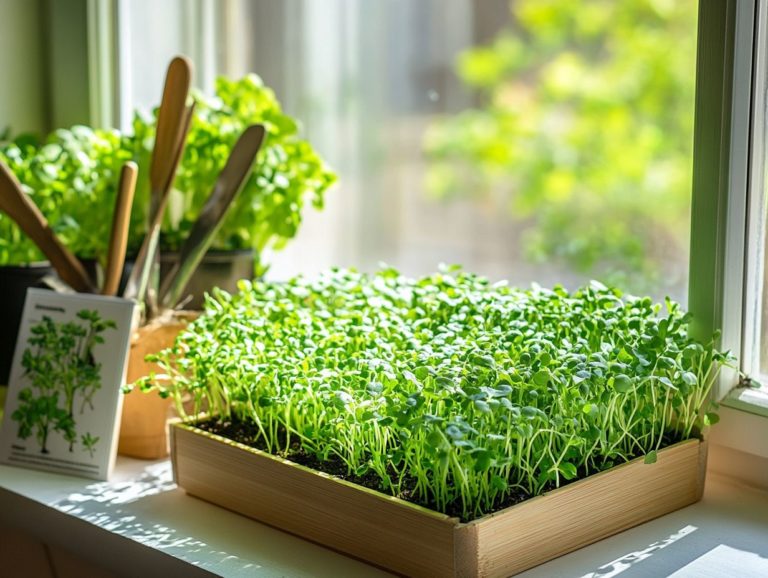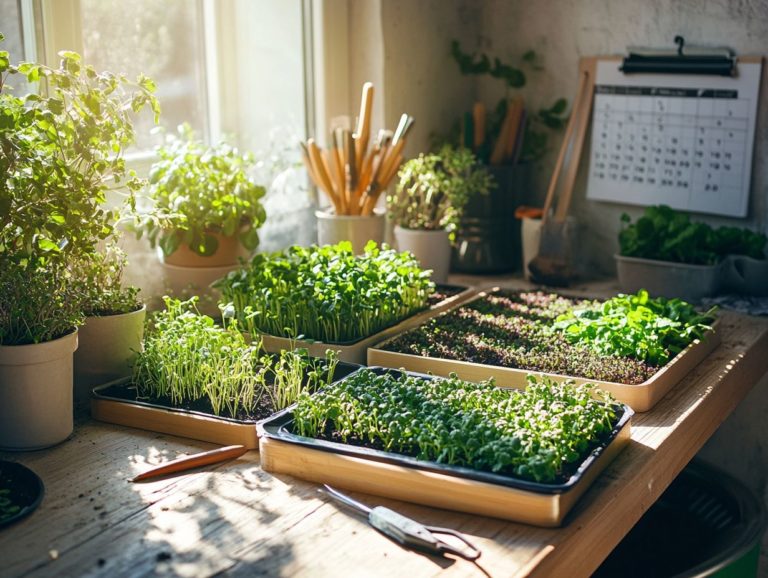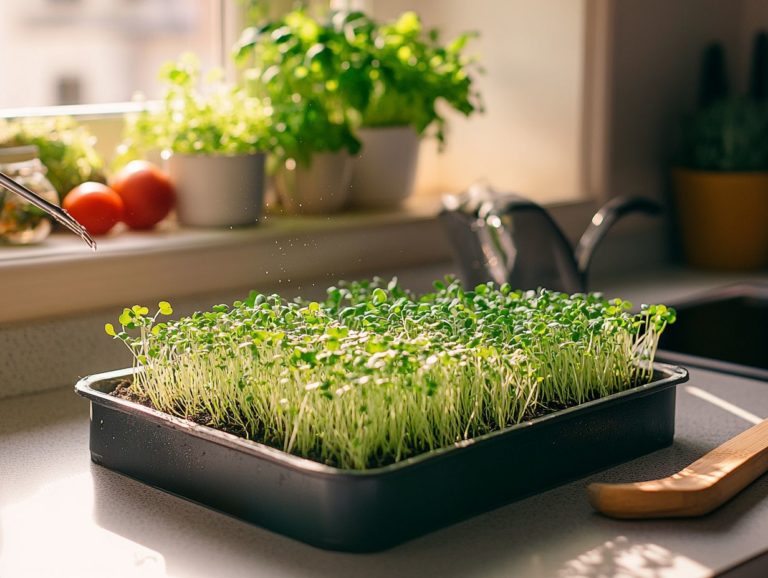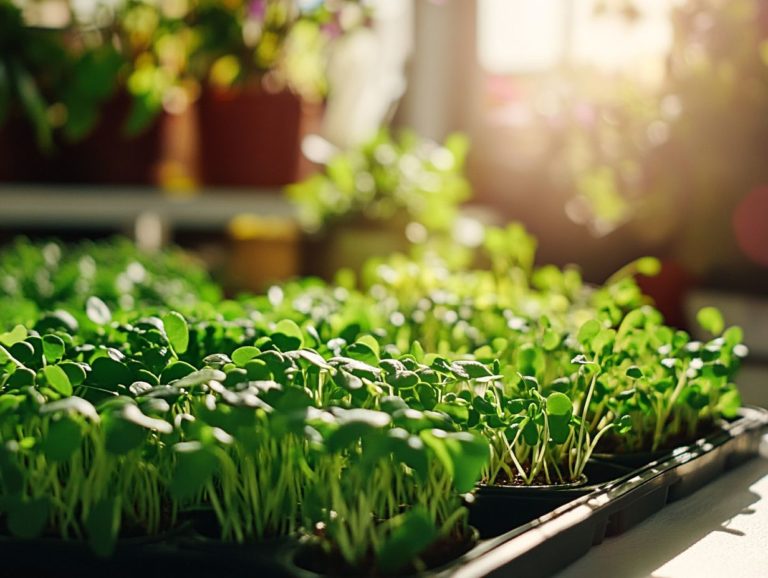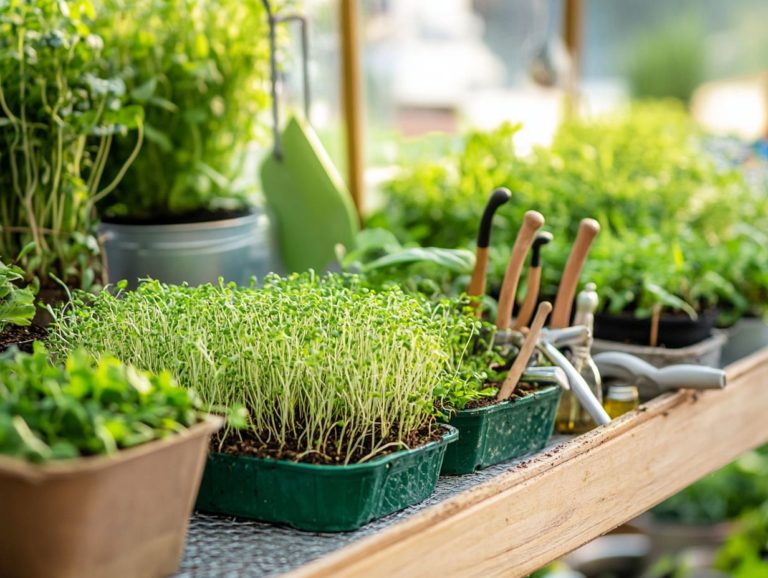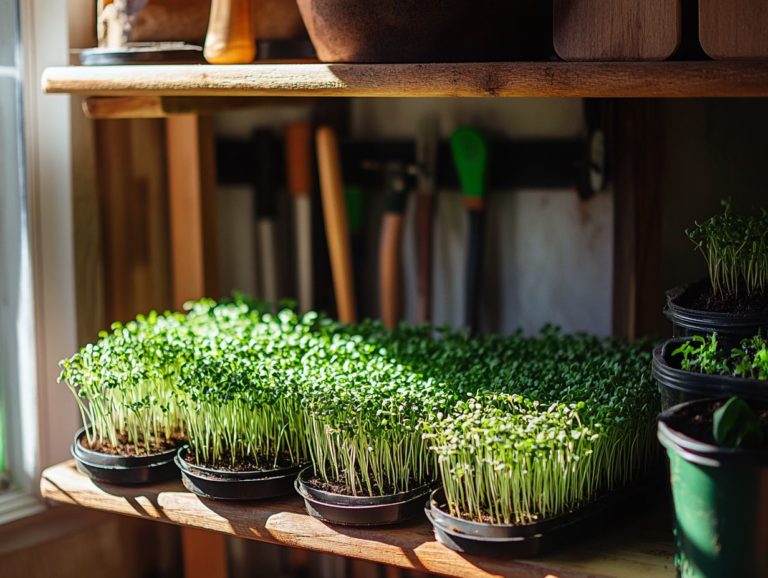How to Troubleshoot Microgreen Growth Problems
Growing microgreens is rewarding, yet it comes with challenges.
You ll face environmental factors like light and humidity, along with nutrient deficiencies and pests. Understanding these issues is key to ensuring a thriving crop.
This guide explores common growth problems. It helps you assess your conditions, diagnose nutrient imbalances, manage pests, and troubleshoot effectively.
With the right measures and tips, you can cultivate healthy microgreens consistently!
Contents
- Key Takeaways:
- Common Microgreen Growth Problems
- Assessing Environmental Factors
- Addressing Nutrient Deficiencies
- Pest and Disease Management
- Troubleshooting Techniques
- Preventive Measures for Future Growth Problems
- Frequently Asked Questions
- 1. How do I know if my microgreens are not growing properly?
- 2. What are some common causes of microgreen growth problems?
- 3. How can I troubleshoot poor quality seed as the cause of my microgreen growth problems?
- 4. How can I tell if my microgreens are not getting enough light?
- 5. How often should I water my microgreens?
- 6. Why is temperature important for microgreen growth?
Key Takeaways:
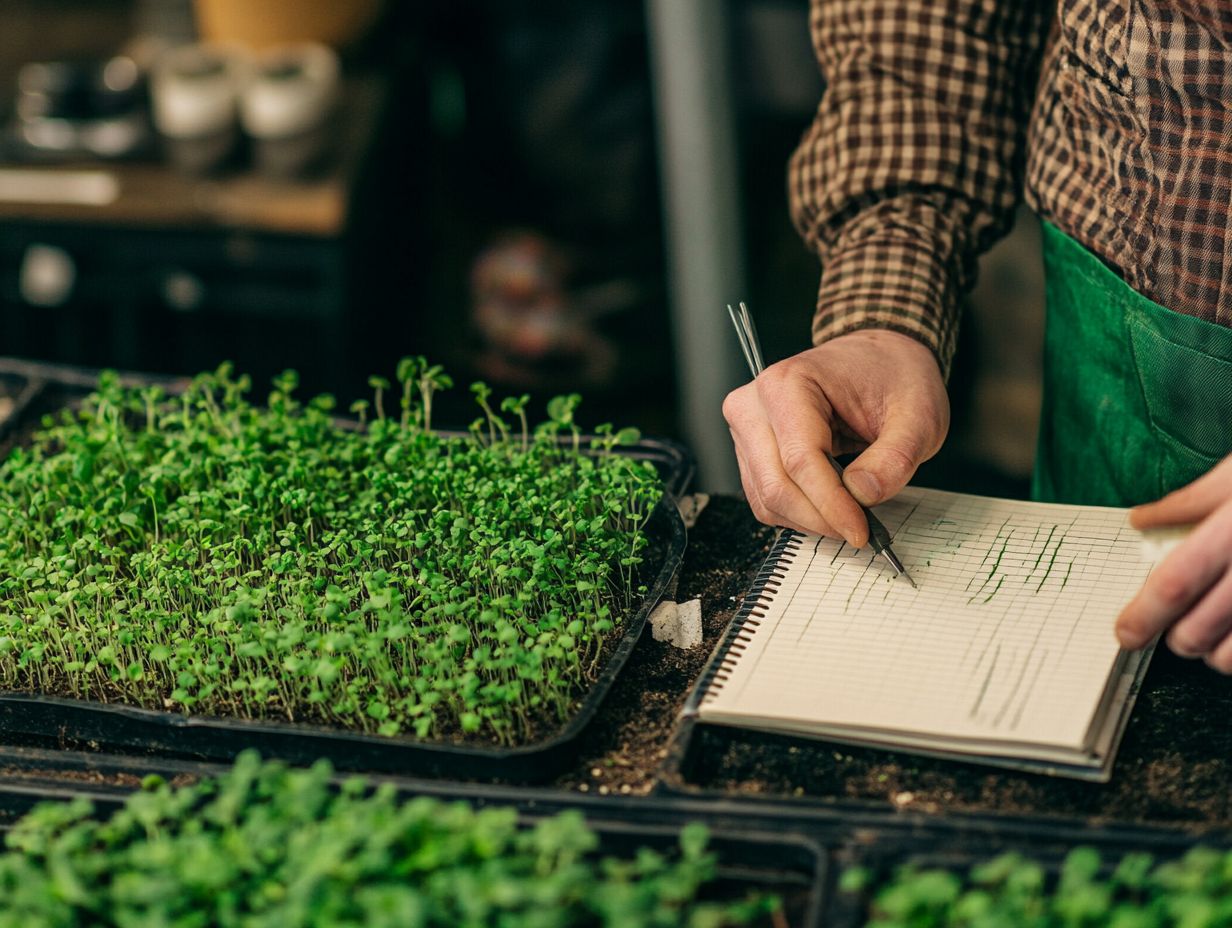
- Be aware of common growth problems, like stunted growth and discoloration.
- Assess environmental factors, such as light and humidity, for optimal microgreen growth.
- Address nutrient deficiencies and implement preventive pest measures.
Common Microgreen Growth Problems
Growing microgreens can be rewarding, but challenges arise.
Common issues include mold, damping off, and seed germination troubles, often linked to environmental factors.
Recognizing these pitfalls is vital for a successful harvest. Humidity imbalances, poor air circulation, and overcrowding significantly impact growth.
Address these concerns early, especially when sourcing seeds from reputable suppliers like Botanical Interests.
Potential Causes and Symptoms
Microgreens can face various growth issues, each with unique causes and symptoms.
Mold growth appears as a fuzzy white or gray coating on soil or plants. This can severely hinder plant vitality.
Damping off causes weak seedlings that may topple or rot at the base, usually due to overly moist conditions.
Slow growth may show as pale, leggy plants struggling to reach their optimal height. Adjusting light, moisture, and temperature levels can help.
Assessing Environmental Factors
Assessing environmental factors is crucial for success in microgreen cultivation.
Light exposure, humidity, and air circulation significantly impact growth rates and plant health.
By monitoring these aspects, you can create ideal conditions for thriving microgreens.
Light, Temperature, and Humidity
The right balance of light, temperature, and humidity is essential for healthy microgreens.
Proper light exposure prevents slow growth. Full-spectrum LED grow lights can enhance photosynthesis, leading to vibrant leaves.
Most microgreens thrive at temperatures between 65 F and 75 F, allowing for rapid growth.
Maintain humidity levels between 40% and 60% to deter mold and balance soil moisture. Careful monitoring creates an ideal environment for robust microgreens and maximizes yield.
Addressing Nutrient Deficiencies
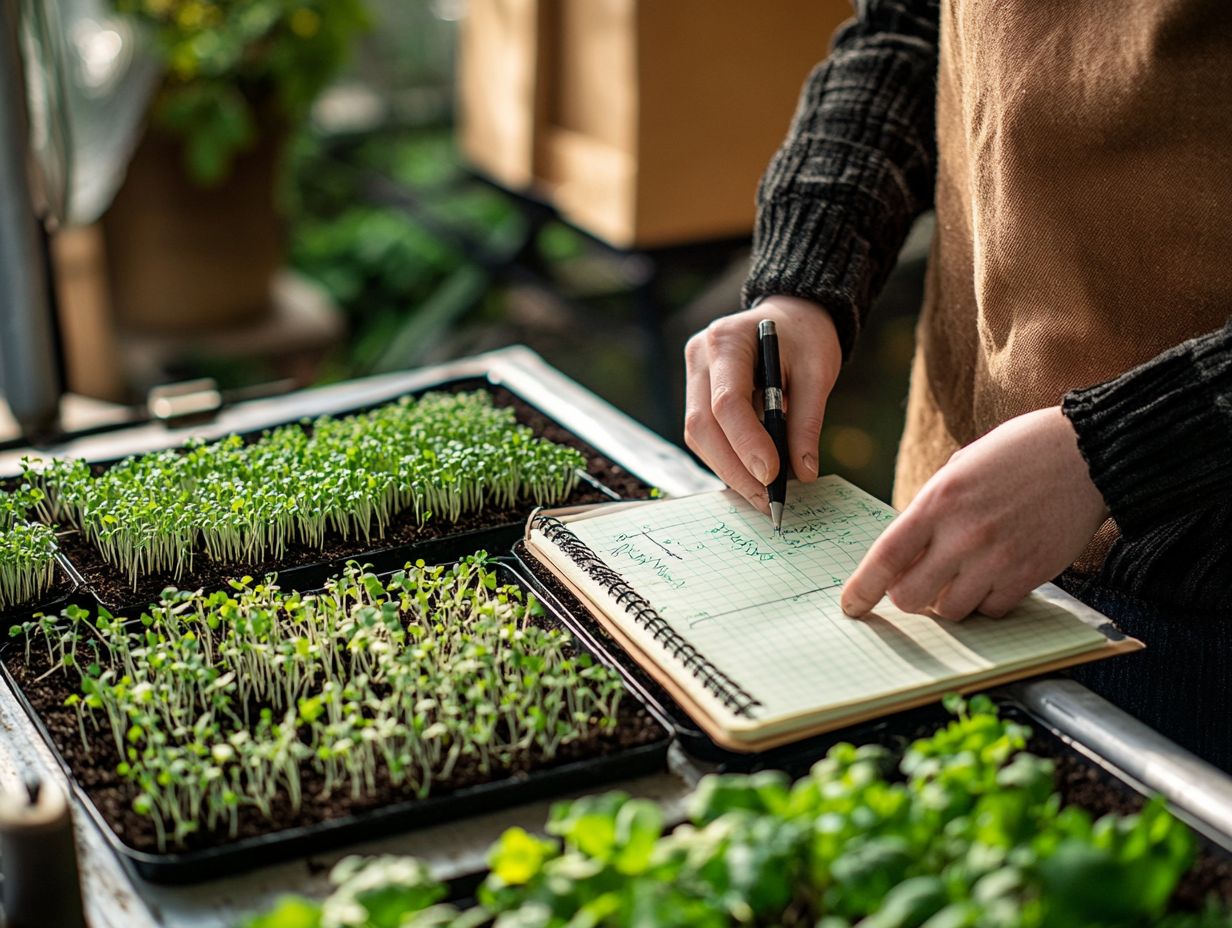
Addressing nutrient deficiencies is crucial for your microgreens. Without essential nutrients, you may experience suboptimal growth and a decline in overall harvest quality due to imbalances in the growing medium.
Prioritizing proper nutrition will ensure that your microgreens thrive and deliver the best possible results.
Identifying and Treating Nutrient Imbalances
Identifying and addressing nutrient imbalances in your microgreens starts with a thorough assessment of the growing medium. You need to check both soil quality and water retention. These factors are key to making nutrients accessible.
By closely observing your microgreens, you may notice visual cues indicating an imbalance, such as discoloration or stunted growth. Good drainage stops root rot and helps nutrients flow well.
Using a well-aerated substrate or incorporating perlite can significantly enhance drainage.
Adjusting pH levels and adding organic amendments will provide a holistic approach to ensuring nutrient balance. This will ultimately promote healthier and more robust microgreens in your garden.
Pest and Disease Management
Effective pest and disease management is essential in microgreen cultivation. Mold and damping off can quickly ruin your crop if you don’t tackle them fast.
By prioritizing these strategies, you can safeguard the health of your microgreens and ensure a thriving harvest.
Prevention and Treatment Strategies
Implementing effective prevention and treatment strategies can significantly reduce the risks associated with mold and other pests. This ensures that optimal conditions like humidity and air circulation are maintained.
Regularly monitor environmental factors and make adjustments as necessary to maintain a stable climate. Utilizing fans can enhance air circulation, key to preventing the dampness that many pests thrive on.
Practicing crop rotation and using well-draining soil can help deter both pests and fungal infections.
Regularly inspect your microgreens for signs of infestation or disease. You’ll be able to intervene quickly whether through organic pesticides or natural remedies like neem oil. To enhance your efforts, familiarize yourself with the understanding microgreen growth phases. Act now to build a thriving microgreen ecosystem that stands strong against common threats!
Troubleshooting Techniques
Troubleshooting microgreens requires a keen eye for recognizing symptoms like slow growth, humidity fluctuations, and mold development. By identifying these issues, you can implement targeted corrective actions to significantly enhance their overall growth performance.
Steps to Identify and Resolve Growth Issues

Identifying and resolving growth issues in your microgreens calls for a systematic approach that focuses on key factors like humidity and air circulation, essential for healthy development.
Begin by assessing the environmental conditions. Microgreens flourish within specific temperature and moisture ranges. Start monitoring humidity levels with a hygrometer; optimal humidity typically falls between 40-60%. Additionally, ensuring the perfect light conditions for microgreens is crucial for their growth.
If you find the humidity is running too high, enhancing ventilation with fans or opening windows can work wonders for air circulation. If humidity levels are too low, a gentle misting of your microgreens can boost moisture without drowning the soil.
Regularly inspecting the growth medium and fine-tuning your watering practices is equally important. Both significantly impact plant health, helping you avoid the top 5 mistakes in growing microgreens and ensuring your microgreens thrive vibrantly and robustly.
Preventive Measures for Future Growth Problems
Implementing preventive measures for microgreens young plants harvested just after their first leaves develop is crucial to ensuring you sidestep potential growth challenges down the line. Addressing issues like mold proactively is key, as neglecting this aspect can severely jeopardize both the health and quality of your crops.
Tips for Maintaining Healthy Microgreens
Maintaining healthy microgreens requires a careful balance of several factors, including adequate air circulation, proper light exposure, and effective drainage. These tiny greens thrive in an environment with plenty of airflow, which helps prevent mold and mildew from taking hold.
Ensure they receive consistent exposure to natural or artificial light ideally around 12 to 16 hours a day to support the process plants use to turn sunlight into energy and enhance their nutrient density. Don’t underestimate humidity! Too much can hinder your microgreens’ growth.
By regularly monitoring these environmental factors, you can ensure your microgreens flourish, yielding a bountiful harvest filled with flavor and essential vitamins.
Frequently Asked Questions
1. How do I know if my microgreens are not growing properly?
If you notice that your microgreens are not growing at the expected rate, or if they appear discolored or wilted, these may be signs of growth problems.
2. What are some common causes of microgreen growth problems?
Poor quality seeds, inadequate lighting, incorrect watering, and improper temperature are some of the common causes of microgreen growth problems.
3. How can I troubleshoot poor quality seed as the cause of my microgreen growth problems?
First, make sure to use high-quality, organic seeds specifically for microgreen growing. If the seeds are not the issue, it could be due to incorrect storage or expiration date.
4. How can I tell if my microgreens are not getting enough light?
If your microgreens appear pale and elongated, it is a sign of inadequate light. Leaning towards a light source indicates they are not getting enough light.
5. How often should I water my microgreens?
Microgreens require frequent, but light watering. Water them once or twice a day, depending on the environment. Keep the soil damp, but not soggy.
6. Why is temperature important for microgreen growth?
Microgreens thrive in a warm and humid environment. If the temperature is too low, growth will slow down; too high can cause the plants to wilt and dry out. Keeping the temperature between 70-75 F is ideal for microgreen growth.
Got more questions? Reach out and let s grow together!
Act now to ensure your microgreens thrive and provide you with a delicious and nutritious harvest!


